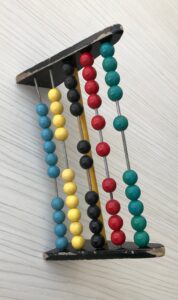
The abacus is a traditional counting tool that has been used for centuries to perform arithmetic calculations. It consists of a rectangular frame with vertical rods, and beads that can slide back and forth on these rods. The abacus is primarily used for teaching and practicing basic mathematical operations, such as addition, subtraction, multiplication, and division.
Here are some ways in which the abacus can help children in grasping math concepts faster and retaining them for a longer period of time:
- Concrete representation: The abacus provides a tangible and visual representation of numbers and their relationships. Children can physically manipulate the beads to perform calculations, which helps them understand the concept of place value and the process of carrying and borrowing in operations.
- Visual and spatial skills: Using an abacus requires children to visually track and mentally manipulate numbers. This enhances their visual and spatial reasoning abilities, which are important for various mathematical tasks, including mental math and problem-solving.
- Multisensory learning: The abacus engages multiple senses, such as sight, touch, and even auditory if the child verbalizes the calculations. This multisensory experience reinforces learning and aids in memory retention.
- Mental calculation: As children practice using the abacus, they gradually internalize the movements and calculations. With enough practice, they can perform mental calculations by visualizing the abacus in their mind, without physically using the tool. This improves their mental math skills and speeds up their calculation abilities.
- Conceptual understanding: The abacus helps children develop a deep understanding of mathematical concepts. By physically moving beads and observing the changes in the abacus, they gain a solid foundation in arithmetic operations and place value. This conceptual understanding forms the basis for advanced mathematical concepts in the future.
- Focus and concentration: Manipulating the abacus requires concentration and focus. As children practice using the tool, they develop the ability to concentrate on tasks for longer periods, which can benefit their overall learning and academic performance.
- Confidence and motivation: The abacus provide children with a hands-on approach to learning math, which can build their confidence and motivation. As they see themselves making progress and solving calculations, they become more enthusiastic about math and are more likely to engage with the subject.

It’s worth noting that while the abacus can be a valuable tool for teaching math, it is not the only method to develop mathematical skills. Different children have different learning styles, and educators often use a combination of approaches to cater to diverse needs.
Penkraft conducts classes, course, online courses, live courses, workshops, teachers’ training & online teachers’ training in Handwriting Improvement, Calligraphy, Abacus Maths, Vedic Maths, Phonics and various Craft & Artforms – Madhubani, Mandala, Warli, Gond, Lippan Art, Kalighat, Kalamkari, Pichwai, Cheriyal, Kerala Mural, Pattachitra, Tanjore Painting, One Stroke Painting, Decoupage, Image Transfer, Resin Art, Fluid Art, Alcohol Ink Art, Pop Art, Knife Painting, Scandinavian Art, Water Colors, Coffee Painting, Pencil Shading, Resin Art Advanced etc. at pan-India locations. With our mission to inspire, educate, empower & uplift people through our endeavours, we have trained & operationally supported (and continue to support) 1500+ home-makers to become Penkraft Certified Teachers? in various disciplines.
